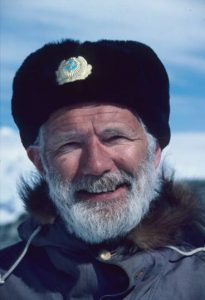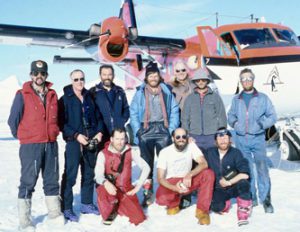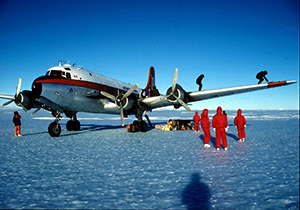Charles Swithinbank
 It is with great sadness that we mark the passing of eminent glaciologist, Dr Charles Swithinbank, whose contributions to polar science are too numerous to be listed here. Born in Burma and raised by an adventurous mother who admonished him not to ‘get stuck in a desk job’, he first traveled to Antarctica as assistant glaciologist with the Norwegian-British-Swedish Antarctic Expedition 1949-52. Thus began a career that spanned more than seven decades, including three winters and more than 20 field seasons in the polar regions.
It is with great sadness that we mark the passing of eminent glaciologist, Dr Charles Swithinbank, whose contributions to polar science are too numerous to be listed here. Born in Burma and raised by an adventurous mother who admonished him not to ‘get stuck in a desk job’, he first traveled to Antarctica as assistant glaciologist with the Norwegian-British-Swedish Antarctic Expedition 1949-52. Thus began a career that spanned more than seven decades, including three winters and more than 20 field seasons in the polar regions.
Antarctic research was a vocation for Charles. He spent many years at the Scott Polar Research Institute (SPRI) and was with the British Antarctic Survey (BAS) from 1974-1986, first as Chief Glaciologist and then as Head of the Earth Sciences Division. After retiring, he remained involved in the interpretation of satellite images of Antarctica, mapping, and the development of ice runways for transport aircraft. It was this last work that was instrumental in opening blue-ice airfields to transport aircraft and the subsequent success of Adventure Network International (ANI) and Antarctic Logistics & Expeditions (ALE).
Charles first spied blue-ice at the base of Patriot Hills in 1975 while working for BAS on radio-echo sounding flights in the Ellsworth Mountains. Both he and BAS pilot Giles Kershaw noted the exposed ice areas at the time and considered they might be smooth enough to land conventional wheeled aircraft without the need for skis. This would enable large, transport aircraft to access the interior of Antarctica.
 In 1986, Giles, now an owner of the fledgling company Adventure Network International, asked Charles to help search for blue-ice areas that might be suitable for landing wheeled aircraft. They flew by ski-equipped Twin Otter from Punta Arenas Chile to Mount Vinson, along with an ANI climbing party that included Reinhold Messner, ANI guide Hector McKenzie, and several other climbers. The Chilean airforce (FACh), at the direction of General Javier Lopetegui, provided support as they were also interested in blue-ice airfields.
In 1986, Giles, now an owner of the fledgling company Adventure Network International, asked Charles to help search for blue-ice areas that might be suitable for landing wheeled aircraft. They flew by ski-equipped Twin Otter from Punta Arenas Chile to Mount Vinson, along with an ANI climbing party that included Reinhold Messner, ANI guide Hector McKenzie, and several other climbers. The Chilean airforce (FACh), at the direction of General Javier Lopetegui, provided support as they were also interested in blue-ice airfields.
Charles had prepared carefully, studying Landsat images to identify every possible blue-ice area. After several days at Vinson Base Camp they flew south, choosing the most economical route that passed near all of them. The first was Wilson Nunataks, where they raised their skis and landed on wheels. From there they continued south and landed at Patriot Hills, the blue-ice area that Giles and Charles had spied twelve years before. Three days of surveying in 20 knot winds revealed a potential 3,000 meter runway, which appeared adequate for transport aircraft.
On the strength of Charles’ report, ANI chartered a DC4 (four-engined, piston-driven airliner with strong landing gear and a slow landing speed) for the following season and invited Charles to accompany them on the first flight to Patriot Hills. Charles decided to go because
‘…if I refused [ANI] would go anyway. If I went, there was a chance that I could stop them from doing something unwise’. He prepared memoranda on how to behave on an icefield, including the question of waste disposal. He wrote, ‘Waste left there will remain exposed for eternity. It will be all too easy to foul the nest with the effluent from human occupation…No Antarctic station in history has ever been situated in an internally-draining bare ice area. We are breaking new ground. The eyes of the world will be upon us. If we mess it up, the wrath of the world will be upon us.’
And so it was that from the beginning, ANI had the benefit of Charles’ vast Antarctic expertise, including practical guidance on environmental protection that has been a watchword for the company ever since.
 On November 21, 1987 the DC4 made its first flight to Patriot Hills, and that season made 13 return flights to Patriot Hills, thus demonstrating the feasibility of carrying useful loads by direct flight from South America to the interior of Antarctica. Now scientists and others could fly from South America and onward to their areas of interest at a fraction of the previous cost. As ANI’s operations grew, so did the need for larger, more reliable aircraft for intercontinental flights. In 1989, ANI switched to a pressurized DC-6B aircraft; in 1993 to a Lockheed Hercules L-382G; and in 2001 to an Ilyushin 76-TD.
On November 21, 1987 the DC4 made its first flight to Patriot Hills, and that season made 13 return flights to Patriot Hills, thus demonstrating the feasibility of carrying useful loads by direct flight from South America to the interior of Antarctica. Now scientists and others could fly from South America and onward to their areas of interest at a fraction of the previous cost. As ANI’s operations grew, so did the need for larger, more reliable aircraft for intercontinental flights. In 1989, ANI switched to a pressurized DC-6B aircraft; in 1993 to a Lockheed Hercules L-382G; and in 2001 to an Ilyushin 76-TD.
In 1988, following an approach by the National Science Foundation (NSF) to the Cold Regions Research and Engineering Laboratory (CRREL), Charles was contracted to identify blue-ice areas that might be used as airfields to support South Pole operations. An examination of 7000 air photos revealed 37 potential runway sites. Charles and Dr Macolm Mellor conducted aerial reconnaissance flights by a ski-wheel Twin Otter and the two most promising sites were ground surveyed. The results were published in the 1989 CRREL report 89-21 Airfields on Antarctic glacier ice.
In 2003 Antarctic Logistics & Expeditions (ALE) purchased the pioneering operator ANI. Charles remained a great friend and advocate of our company and we can certainly vouch for the fact that he never ‘got stuck in a desk job’! His last journey to the Antarctic interior was in 2010 with Javier Lopetegui and his wife Elvira, when they flew via Ilyushin 76-TD to ALE’s new runway and camp at Union Glacier. During Charles’ time in camp, he gave a lecture entitled ’60 Years on Ice’, in which he recounted some of his many accomplishments and adventures in Antarctica.
Charles was an extraordinary man and a great mentor to ALE, and he will be sorely missed by the many people whose lives he touched. His longtime friend, Javier Lopetegui wrote these touching words,
“I am deeply moved by the news of Charles passing. I am conscious there is a difference between having known and sharing with Charles in the early years of his Blue Ice discovering when I was there, and to know “about” Charles achievements in Antarctica by the younger generations, however, I am sure all of us will miss him equally.”
American Polar Society Polar Luminary: www.americanpolar.org/charles-swithinbank/
Scott Polar Research Institute: www.spri.cam.ac.uk/people/swithinbank/
National Life Stories (Interview with Charles Swithinbank): http://sounds.bl.uk/related-content/TRANSCRIPTS/021T-C1379X0003XX-0000A0.pdf
The Telegraph: Charles Swithinbank Obituary